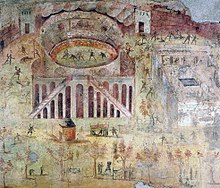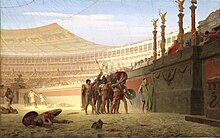Velarium



A velarium ("curtain")[3] was a type of awning used in Roman times. It stretched over the whole of the cavea, the seating area in amphitheaters, to protect spectators from the sun.[4][2] Retractable awnings were relatively common throughout the Roman Empire. Though the precise details are unclear, the awning was evidently usually supported by wooden masts, the sockets and brackets for which remain on the Colosseum and Arena of Nîmes, for example.[5][6][2]
The Colosseum
[edit]The Colosseum being the biggest amphitheater of Roman times, the velarium that covered it was the biggest that ever was as well. It provided shade from the sun for up to one third of the arena. The velarium also created a ventilation updraft, creating circulation and a cool breeze.[2]
It is believed that sailors from the Misenum fleet, with their background in sailmaking and rigging were employed to build, maintain and operate the velarium.
In modern times
[edit]The Puy du Fou theme park, in France, has a Roman-style amphitheatre built for some of its shows, complete with an antique-style velarium.


References
[edit]- ^ Clauss, Manfred; Kolb, Anne; Slaby, Wolfgang A.; Woitas, Barbara. "Epigraphik Datenbank". db.edcs.eu. Retrieved 28 June 2021.
CIL 04, 07992 = GladPar 00007 = AE 1991, +00433
- ^ a b c d "Was the Colosseum covered? The story of the Velarium". Through Eternity. 2019-03-29. Retrieved 2021-06-29.
- ^ Cf. velum, "veil, sail".
- ^ "Awning at the Colosseum".
- ^ Yarwood, Doreen, The Architecture of Europe, p. 58, 1987 (first edn. 1974), Spring Books, ISBN 0600554309; Juvenal iv.121
- ^ Suetonius, Life of Caligula 26 (Text).
Text is available under the CC BY-SA 4.0 license; additional terms may apply.
Images, videos and audio are available under their respective licenses.
